Neococytius cluentius
|
|
Updated as per http://biological-diversity.info/sphingidae.htm (Belize), November 2007
Updated as per Fauna Entomologica De Nicarauga, November 2007
Updated as per The Known Sphingidae of Costa Rica, November 2007
Updated as per personal communication with Vladimir Izersky (early September, late November, Coviriali, Junin, Peru, 662m), December 20, 2008
Updated as per personal communication with Ezequiel Bustos (Aguas Blancas, Salta, Argentina, 405m); December 2009
Updated as per SHILAP publication: Lista de Sphingidae del Uruguay, September, 2010; Msc Gabriela Bentancur Viglione; January 31, 2011
Updated as per personal communication with Gregory Nielsen (Colombia: Meta; 500m; February 23, 2011, 120mm); March 6, 2011
Updated as per French Guiana Sphingidae; March 9, 2011
Updated as per personal communication with Andres Urbas (near Kaw Mountains, French Guiana, March 31, 2011); April 19, 2011
Updated as per personal communication with Robin Crain (La Selva, Heredia, Costa Rica); September 27, 2012
Updated as per "A Hawk Moths fauna of southern Maranhão state, Brazil, ... "; NEVA: Jahrgang 34 Heft 3 November 2013; via Jean Haxaire; April 5, 2014
Updated as per personal communication with Sergio D. Ríos Díaz in CATÁLOGO DE LOS SPHINGIDAE (INSECTA: LEPIDOPTERA) DEPOSITADOS EN
EL MUSEO NACIONAL DE HISTORIA NATURAL DEL PARAGUAY; sent to me in July 2014 by Sergio D. Ríos Díaz.
Updated as per personal communication with Steve Nanz (Arima, St. George, Trinidad, March 23, 2015); March 29, 2015
Updated as per personal communication with Ezequiel Bustos (Shilap revta. lepid. 43 (172) diciembre, 2015, 615-631 eISSN 2340-4078 ISSN 0300-5267), January 4, 2016
Updated as per personal communication with Nazare Pereira Gottgtroy (Itumirim, Minas Gerais, Brazil, June 8, 2016), June 8, 2016
Updated as per personal communication with Rodrigo Dela Rosa (Soa Jose dos Campos, Sao Paulo, Brazil, January 16, 2017), March 15, 2017
|
Neococytius cluentius
nee-oh-koh-SIT-ee-usM klue-EN-tee-us
(Cramer, 1775) Sphinx
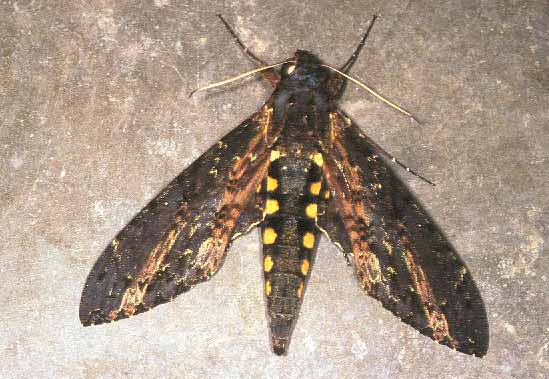
Neococytius cluentius from Rancho Grande,
H. Pittier National Park, Venezuela
courtesy of Paolo Mazzei.
This site has been created by Bill Oehlke.
Comments, suggestions and/or additional information are welcomed by Bill.
TAXONOMY:
Family: Sphingidae, Latreille, 1802
Subfamily: Sphinginae, Latreille, [1802]
Tribe: Sphingini, Latreille, 1802
Genus: Neococytius Hodges, 1971 ...........
Species: cluentius (Cramer, 1775)
|
DISTRIBUTION:
The Cluentius Sphinx, Neococytius cluentius
(Wing span: 5 1/2 - 6 5/16 inches (14 - 16 cm)], flies
in tropical and subtropical lowlands in the "West Indies",
the specimen type locality, and from the southern U.S. (strays:
north to Mississippi, northern Illinois, and southern
Michigan) and
Mexico;
Belize: Corozol, Cayo, Stann Creek, Toledo;
Guatemala: Izabal (JM);
Nicaragua: Rio San Juan;
Costa Rica: Guanacaste, Puntarenas, Lemon,
Alajuela, Heredia, San Jose, Carthage; through
Colombia; Meta (GN);
French Guiana: Kaw;
Venezuela;
Trinidad: St. George: Arima (SN);
Peru: Junin (662-950m) to
Paraguay: San Pedro; Canindeyu;
Argentina: Salta (405m EB); Chaco; La Rioja; Misiones; Santa Fe; Tucuman; Antilles, and into
Bolivia: Santa Cruz: Andrés Ibáñez, Potrerillos del Güendá;
Andrés Ibáñez; Ichilo, La Víbora; Buena Vista;
Parque Nacional Amboró, Río Saguayo;
Santa Cruz: Ñuflo de Chávez, Esperanza; Ichilo, Buena Vista, 750m,
Sarah, 450m; Cochabamba;
Brazil: southern Maranhao; Minas Gerais; Sao Paulo (RDR); and
Uruguay.
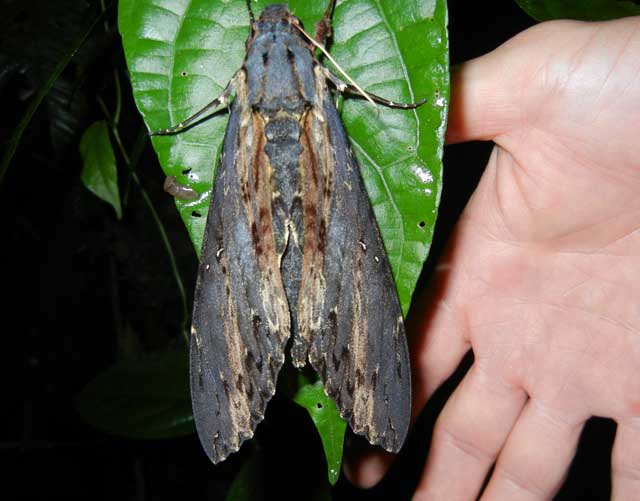
Neococytius cluentius, La Selva, Heredia, Costa Rica,
courtesy of Robin Crain.
Robin Crain writes, "I'm a high school science teacher in Spokane, WA. On a recent trip to La Selva I came across the moth on the attached photo.
The size was amazing (to me anyway) but more amazing was a behavior that the moth exhibited. I went to gently lift the side of the wing to view the
bright orange spotted abdomen and the moth jettisoned a large amount of liquid from its posterior. I'm guessing it was urine or water and a defensive
behavior. I jumped back and the moth remained looking just as contented as before. Any insights as to the moth species and behavior?
I do have several additional pictures but the attached is the best. Thanks."
I reply, "Thanks for sharing beautiful image of Neococytius cluentius, the Cluentius Sphinx.
I suspect this moth is newly emerged from its pupal shell and probably has not even flown yet. While it the pupal stage, the developing moth
was accumulating metabolic wastes which it was unable to discharge. Many Sphingidae and Saturniidae will release that waste just prior to their first flight
or when disturbed. Otherwise, the fluid could be a discharge as you have suggested.
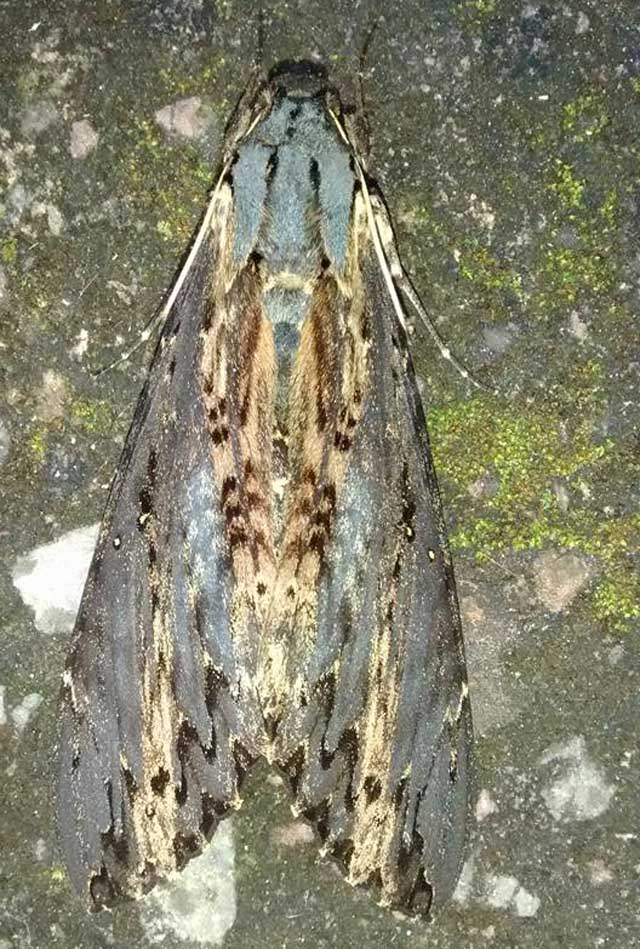
Neococytius cluentius, Itumirim, Minas Gerais, Brazil,
June 8, 2016, courtesy of Nazare Pereira Gottgtroy.
I suspect it also flies in Guyana and Suriname.
The upper side of the forewing is a grey to blurry black with pale orange to pale beigey-brown markings.
The upperside of the hindwing is black with
orange at the base and orangish yellow patches between the veins,
forming a band across the wing.
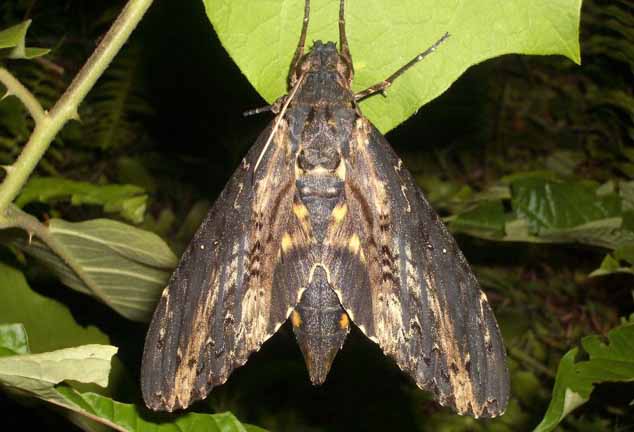
Neococytius cluentius,
resting by the side of a track near Sherwood Forest,
Portland, Jamaica, July 2004, courtesy of
Tony and Pat James.
The proboscis is over nine inches long.
Both males and females come to lights.
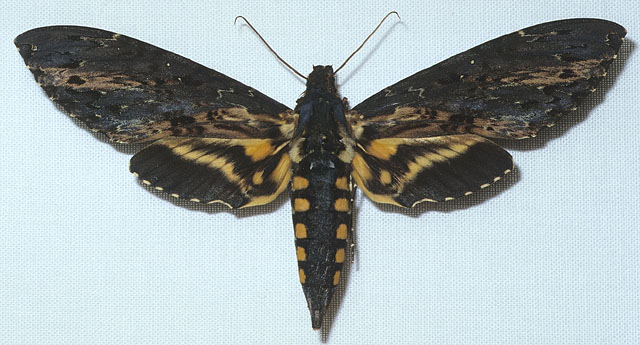
Neococytius cluentius, female, courtesy
of Hubert Mayer
FLIGHT TIMES:
Neococytius cluentius adults
nectar at flowers and brood continuously, having at least three
generations, in the tropics:
1) December-January;
2) May-June; (July in Jamaica)
3) October.
Andres Urbas reports a March 31, 2011, flight near KAW Mountains, French Guiana.
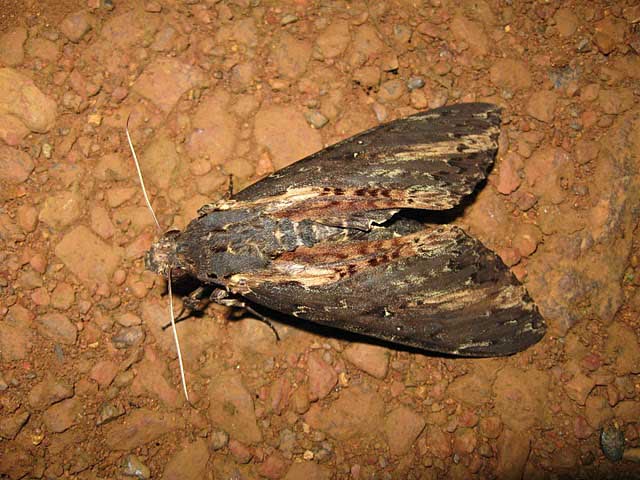
Neococytius cluentius, near Kaw Mountains, French Guiana,
March 31, 2011, courtesy of Andres Urbas.
Females begin flight shortly after midnight and continue til 2:30 am while males
fly from 1:30-4:30 am.
In Bolivia specimens have been taken in March-April-May-June, August,
October-November-December.
Vladimir Izersky reports them on the wing in Coviriali, Junin, Peru, in early September and in late November.
There is at least a February flight in French Guiana.
Gregory Nielsen reports a February 23, 2011, flight in Meta, Colombia.
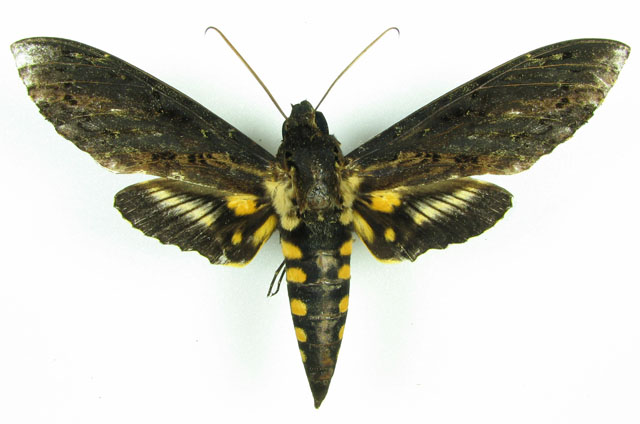
Neococytius cluentius, Colombia. Depto Meta: Villavicencio-Villacentro
04°03’55.0 N 073°41’87.0 W, 500m 23- ii-2011 leg. G. Nielsen,
id and slight digital repair by Bill Oehlke
ECLOSION:
Pupae probably wiggle to surface from subterranean chambers just prior to eclosion.
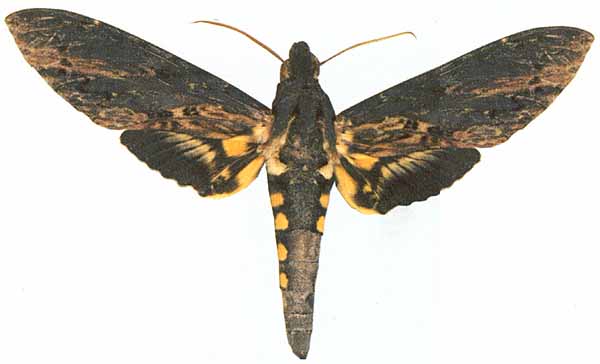
Neococytius
cluentius courtesy of Vladimir Izersky
SCENTING AND MATING:
Females call in the males with a pheromone released from a gland at the tip of the
abdomen.
EGGS, LARVAE, PUPAE:
Caterpilars feed on plants in the
custard apple family (Annonaceae) and the piper
family (Piperaceae). Ipomoea batatas of the Convolvulaceae family has been
reported as a host.
Use your browser "Back" button to return to the previous page.
Return to Sphingidae Index
Return to Sphingini Tribe
Use your browser "Back" button to return to the previous page.
This page is brought to you by
Bill Oehlke and the
WLSS. Pages are on space rented from Bizland. If you would like
to become a "Patron of the Sphingidae Site", contact Bill.
Please send sightings/images to Bill. I will do my best to respond to
requests for identification help.
Enjoy one of nature's wonderments: Live
Saturniidae (Giant Silkmoth) cocoons.
 | 
Show appreciation for this site by clicking on flashing butterfly to the left.
The link will take you to a page with links to many insect sites. |
This website has been created and is maintained by Bill Oehlke without government or institutional financial assistance. All expenses, ie., text reference
support material, webspace rental from Bizland, computer repairs/replacements, backups systems, software for image adjustments (Adobe Photoshop; L-View),
ftp software, anti-virus protection, scanner, etc. are my own.
I very much appreciate all the many images that have been sent to me, or of which I have been granted permission to copy and post from other websites.
All images on this site remain the property of respective photographers.
If you would like to contribute to the maintenance of this website by sending a contribution to
Bill Oehlke
Box 476
155 Peardon Road
Montague, Prince Edward Island, C0A1R0
Canada
your donation would be much appreciated and would be used for
1) paying for webspace rental;
2) paying for computer maintenance and software upgrades;
3) purchases of additional text reference material (journals and books) in anticipation of expanding the site to a worldwide Sphingidae site;
4) helping to pay my daughter's tuition (completed spring of 2013); with anything left over going to humanitarian aid.
If you are mailing a check from USA, please use $1.25 (2015 rate) postage. Donations can also be made through Paypal via the button below.









